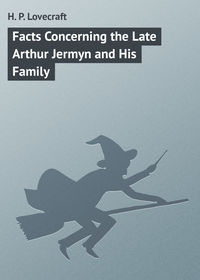Kitap dosya olarak indirilemez ancak uygulamamız üzerinden veya online olarak web sitemizden okunabilir.
Kitabı oku: «Facts Concerning the Late Arthur Jermyn and His Family», sayfa 3
II
Arthur Jermyn was the son of Sir Alfred Jermyn and a music-hall singer of unknown origin. When the husband and father deserted his family, the mother took the child to Jermyn House; where there was none left to object to her presence. She was not without notions of what a nobleman’s dignity should be, and saw to it that her son received the best education which limited money could provide. The family resources were now sadly slender, and Jermyn House had fallen into woeful disrepair, but young Arthur loved the old edifice and all its contents. He was not like any other Jermyn who had ever lived, for he was a poet and a dreamer. Some of the neighbouring families who had heard tales of old Sir Wade Jermyn’s unseen Portuguese wife declared that her Latin blood must be showing itself; but most persons merely sneered at his sensitiveness to beauty, attributing it to his music – hall mother, who was socially unrecognised. The poetic delicacy of Arthur Jermyn was the more remarkable because of his uncouth personal appearance. Most of the Jermyns had possessed a subtly odd and repellent cast, but Arthur’s case was very striking. It is hard to say just what he resembled, but his expression, his facial angle, and the length of his arms gave a thrill of repulsion to those who met him for the first time.
It was the mind and character of Arthur Jermyn which atoned for his aspect. Gifted and learned, he took highest honours at Oxford and seemed likely to redeem the intellectual fame of his family. Though of poetic rather than scientific temperament, he planned to continue the work of his forefathers in African ethnology and antiquities, utilising the truly wonderful though strange collection of Sir Wade. With his fanciful mind he thought often of the prehistoric civilisation in which the mad explorer had so implicitly believed, and would weave tale after tale about the silent jungle city mentioned in the latter’s wilder notes and paragraphs. For the nebulous utterances concerning a nameless, unsuspected race of jungle hybrids he had a peculiar feeling of mingled terror and attraction, speculating on the possible basis of such a fancy, and seeking to obtain light among the more recent data gleaned by his great-grandfather and Samuel Seaton amongst the Ongas.
In 1911, after the death of his mother, Sir Arthur Jermyn determined to pursue his investigations to the utmost extent. Selling a portion of his estate to obtain the requisite money, he outfitted an expedition and sailed for the Congo. Arranging with the Belgian authorities for a party of guides, he spent a year in the Onga and Kahn country, finding data beyond the highest of his expectations. Among the Kaliris was an aged chief called Mwanu, who possessed not only a highly retentive memory, but a singular degree of intelligence and interest in old legends. This ancient confirmed every tale which Jermyn had heard, adding his own account of the stone city and the white apes as it had been told to him.
According to Mwanu, the gray city and the hybrid creatures were no more, having been annihilated by the warlike N’bangus many years ago. This tribe, after destroying most of the edifices and killing the live beings, had carried off the stuffed goddess which had been the object of their quest; the white ape-goddess which the strange beings worshipped, and which was held by Congo tradition to be the form of one who had reigned as a princess among these beings. Just what the white apelike creatures could have been, Mwanu had no idea, but he thought they were the builders of the ruined city. Jermyn could form no conjecture, but by close questioning obtained a very picturesque legend of the stuffed goddess.
The ape-princess, it was said, became the consort of a great white god who had come out of the West. For a long time they had reigned over the city together, but when they had a son, all three went away. Later the god and princess had returned, and upon the death of the princess her divine husband had mummified the body and enshrined it in a vast house of stone, where it was worshipped. Then he departed alone. The legend here seemed to present three variants. According to one story, nothing further happened save that the stuffed goddess became a symbol of supremacy for whatever tribe might possess it. It was for this reason that the N’bangus carried it off. A second story told of a god’s return and death at the feet of his enshrined wife. A third told of the return of the son, grown to manhood – or ape-hood or godhood, as the case might be – yet unconscious of his identity. Surely the imaginative blacks had made the most of whatever events might lie behind the extravagant legendry.
